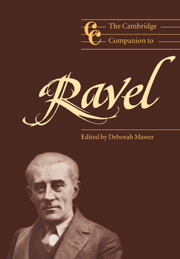Book contents
- Frontmatter
- Introduction
- Part I Culture and aesthetic
- Part II Musical explorations
- Part III Performance and reception
- 10 Performing Ravel: style and practice in the early recordings
- 11 Ravel and the twentieth century
- Appendix: Early reception of Ravel's music (1899–1939)
- Notes
- Select bibliography
- Index of names and works
11 - Ravel and the twentieth century
from Part III - Performance and reception
Published online by Cambridge University Press: 28 September 2011
- Frontmatter
- Introduction
- Part I Culture and aesthetic
- Part II Musical explorations
- Part III Performance and reception
- 10 Performing Ravel: style and practice in the early recordings
- 11 Ravel and the twentieth century
- Appendix: Early reception of Ravel's music (1899–1939)
- Notes
- Select bibliography
- Index of names and works
Summary
No sane commentator has ever doubted Ravel's talent. He was a wonderful technician, a superb orchestrator, a consummate stylist … but … The sense of disappointment is as often an undertow as a fully fledged current. Jim Samson, for instance, sums up Ravel's harmonic practice by saying that ‘ultimately … the more astringent harmonies in his music are an extension and enrichment of a traditional type of tonal thinking rather than a reshaping of tonality along new, radical lines’. Samson might reasonably argue that this is a neutral, non-value judgement; but in the context of a book entitled Music in Transition it is, I submit, easier to read it as a criticism than as a eulogy. There is surely more than a little truth in Michael Russ's contention with regard to the two piano concertos that ‘Musicology is wary of declaring as “canonic” works which set out to entertain rather than those which confront the audience with what it might find unpalatable as a necessary part of discovery and self-expression’ (‘The Concerto in G and jazz’: Chapter 6). It is, in essence, the ways in which Ravel is thought to fall short of the canonic, the ‘but’ of my first paragraph, that I want to examine, for what they tell us not only about Ravel but also about the twentieth century and the demands it has made of its ‘serious’ composers.
- Type
- Chapter
- Information
- The Cambridge Companion to Ravel , pp. 240 - 250Publisher: Cambridge University PressPrint publication year: 2000
- 3
- Cited by

